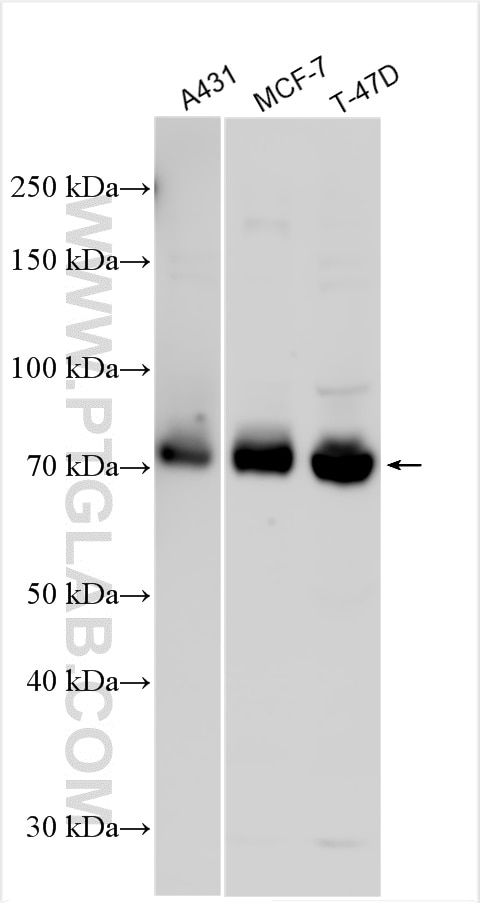GALNT6 Polyklonaler Antikörper
GALNT6 Polyklonal Antikörper für WB, ELISA
Wirt / Isotyp
Kaninchen / IgG
Getestete Reaktivität
human
Anwendung
WB, ELISA
Konjugation
Unkonjugiert
Kat-Nr. : 13671-1-AP
Synonyme
Galerie der Validierungsdaten
Geprüfte Anwendungen
| Erfolgreiche Detektion in WB | A431-Zellen, MCF-7-Zellen, T-47D-Zellen |
Empfohlene Verdünnung
| Anwendung | Verdünnung |
|---|---|
| Western Blot (WB) | WB : 1:2000-1:12000 |
| It is recommended that this reagent should be titrated in each testing system to obtain optimal results. | |
| Sample-dependent, check data in validation data gallery | |
Produktinformation
13671-1-AP bindet in WB, ELISA GALNT6 und zeigt Reaktivität mit human
| Getestete Reaktivität | human |
| Wirt / Isotyp | Kaninchen / IgG |
| Klonalität | Polyklonal |
| Typ | Antikörper |
| Immunogen | GALNT6 fusion protein Ag4652 |
| Vollständiger Name | UDP-N-acetyl-alpha-D-galactosamine:polypeptide N-acetylgalactosaminyltransferase 6 (GalNAc-T6) |
| Berechnetes Molekulargewicht | 622 aa, 71 kDa |
| Beobachtetes Molekulargewicht | 71 kDa |
| GenBank-Zugangsnummer | BC035822 |
| Gene symbol | GALNT6 |
| Gene ID (NCBI) | 11226 |
| Konjugation | Unkonjugiert |
| Form | Liquid |
| Reinigungsmethode | Antigen-Affinitätsreinigung |
| Lagerungspuffer | PBS mit 0.02% Natriumazid und 50% Glycerin pH 7.3. |
| Lagerungsbedingungen | Bei -20°C lagern. Nach dem Versand ein Jahr lang stabil Aliquotieren ist bei -20oC Lagerung nicht notwendig. 20ul Größen enthalten 0,1% BSA. |
Hintergrundinformationen
GALNT6 (polypeptide N-acetylgalactosaminyltransferase 6, GalNAc-T6), which is involved in the initiation of O-glycosylation, has been reported to play crucial roles in mammary carcinogenesis through binding to several substrates (PMID: 32393740). GALNT6 is upregulated in breast, ovarian, renal cell, lung and pancreatic cancers (PMID: 20215525). Overexpression of GRP78 could enhance Golgi-to-ER relocation of GALNT6 (PMID: 28110670).
Protokolle
| Produktspezifische Protokolle | |
|---|---|
| WB protocol for GALNT6 antibody 13671-1-AP | Protokoll herunterladen |
| Standard-Protokolle | |
|---|---|
| Klicken Sie hier, um unsere Standardprotokolle anzuzeigen |


